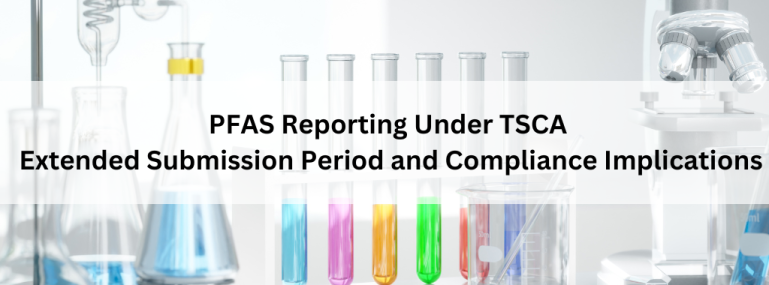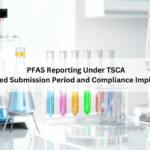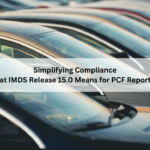EPA’s TSCA PFAS reporting rule is one of the most challenging compliance requirements that chemical manufacturers, importers, and many downstream users have faced in recent years. The government has shifted the start and end dates of the data submission period to May 2025. This change impacts recordkeeping, internal deadlines, software preparedness, and planning for anyone importing PFAS between 2011 and 2022.
A summary of the amendment:
- EPA established the general end date of the PFAS data submission period as October 13, 2026, with the start date set for April 13, 2026. The alternative deadline for small manufacturers who only report articles as importers is April 13, 2027.
- To allow time for adjustment and development of reporting software, EPA deferred the beginning date by nine months (from July 11, 2025) and provided 30 days for public comments on the change, which was issued as a temporary final rule in May 2025.
- Submission windows and some technical text revisions were the only changes made. The underlying TSCA PFAS reporting requirement remains in effect, covering any PFAS produced or imported between 2011 and 2022.
Who needs to pay attention:
- Small manufacturers who only report articles as importers (deadline: April 13, 2027).
- PFAS manufacturers and importers (including imports in products) that have produced or imported listed PFAS in any year from 2011–2022.
- Product sellers, supply chain and compliance teams, legal departments, and consultants who prepare TSCA submissions for companies.
High-level information required by the rule:
Under Section 8(a)(7) PFAS reporting, companies must provide comprehensive information, including (but not limited to):
- Identification of imported or manufactured PFAS (CAS, name).
- Annual volume of imports and production (2011–2022).
- Byproducts, uses (including articles), and waste management/disposal.
- Equipment related to environmental releases, worker exposure risks, and any available health and safety information.
- Documentation to substantiate reported values and claims (e.g., CBI).
(The adjustment to the submission period does not alter these core reporting and recordkeeping requirements.)
Practical effect of the submission period extension:
- More time to collect data: With the deadline moved to April 2026, companies now have several months to track imports, identify PFAS in products, and compile historical records. This should reduce rushed or inaccurate submissions.
- Software preparedness: EPA noted that part of the delay was due to the need to complete reporting tools and software. Companies should monitor EPA guidelines and approved reporting formats.
- Preparation for CBI claims: Companies intending to request Confidential Business Information (CBI) protection for volumes, uses, or processing details must prepare strong justifications and supporting documentation. EPA will scrutinize these claims closely.
- Opportunity to respond or comment: EPA indicated it may reopen other parts of the rule in the future. In May 2025, public comments were accepted on the submission change. Companies should monitor announcements in the Federal Register.
Suggested immediate tasks:
1.Check ownership and scope
Decide which internal team (regulatory, product stewardship, or compliance) will manage the effort.
2.Develop a PFAS inventory (2011–2022)
Collect production, customs, and procurement information (HTS codes and article records). Flag all materials containing PFAS.
3.Compile all necessary documents
Include waste/disposal logs, production records, purchase orders, supplier declarations, SDSs, formulas, and test results. Maintain metadata and chain of custody.
4.Identify gaps and data sources
Build a spreadsheet mapping required reporting elements, data sources, and responsible contacts (starting with key product lines and years).
5.Plan for CBI claims
Decide what, if anything, will be claimed as CBI. Prepare legal and technical justifications with supporting evidence.
6.Monitor EPA software and instructions
Track updates on the EPA PFAS reporting portal. Subscribe to the EPA TSCA PFAS page and Federal Register announcements.
7.Consider external support
If in-house resources are limited, seek help from regulatory lawyers, technical experts, or industry associations familiar with PFAS reporting.
Best practices for recordkeeping:
- Maintain an audit trail linking reported figures to original documentation (e.g., invoices, manifests).
- Use backups or hash checks for electronic records. EPA may request supporting documents after submission.
- For estimates, maintain version control and an evidence log showing how and why values were created.
- Retain records for the EPA-mandated storage period.
Risk and enforcement:
Under TSCA, companies may face enforcement actions and fines for failing to report or for submitting inaccurate information. The extended submission window does not change these obligations. Instead of pausing work, companies should use the extra time to improve accuracy and completeness.
To stay updated:
- Follow official EPA guidance and portal updates on the TSCA PFAS page.
- Monitor Federal Register notices for official rule changes.
- Review SBA summaries, industry association updates, and law firm advisories.
The TSCA PFAS reporting window now runs from April 13 to October 13, 2026 (with April 13, 2027 for small article importers). While the extension provides more time to collect data and prepare systems, it is not an excuse to delay critical tasks. Companies should immediately decide on their CBI strategy, build inventories, finalize documentation, and stay aligned with EPA updates on reporting tools and guidance.
ComplianceXL can help organizations navigate these new timelines by providing expertise in PFAS inventory creation, CBI justification, and TSCA submission management. With the right planning and compliance strategy, companies can avoid risks and ensure timely, accurate reporting.
FAQs
1. What are the reporting rules for TSCA PFAS?
Between January 1, 2011, and December 31, 2022, companies that manufactured or imported PFAS for commercial use are required to report under TSCA Section 8(a).
Required data includes:
- Chemical identification of PFAS (name, CAS, structural details).
- Annual production, processing, or import volumes.
- Uses and categories of use.
- Byproducts, exposure, worker, environmental, waste, and disposal information.
- Any existing health and environmental effects data.
- Additionally, companies must maintain documentation supporting reported values and claims (e.g., CBI requests).
2. How has the submission deadline changed?
- On May 13, 2025, EPA published a temporary final rule postponing the submission window by about nine months.
- For most manufacturers and importers, the new reporting window is April 13, 2026 – October 13, 2026.
- For small manufacturers only reporting articles as importers, the deadline is April 13, 2027.
- Importantly, only the dates have changed. The core reporting requirements remain the same. EPA accepted public comments on the revised timeline for 30 days, and the rule became effective immediately.





